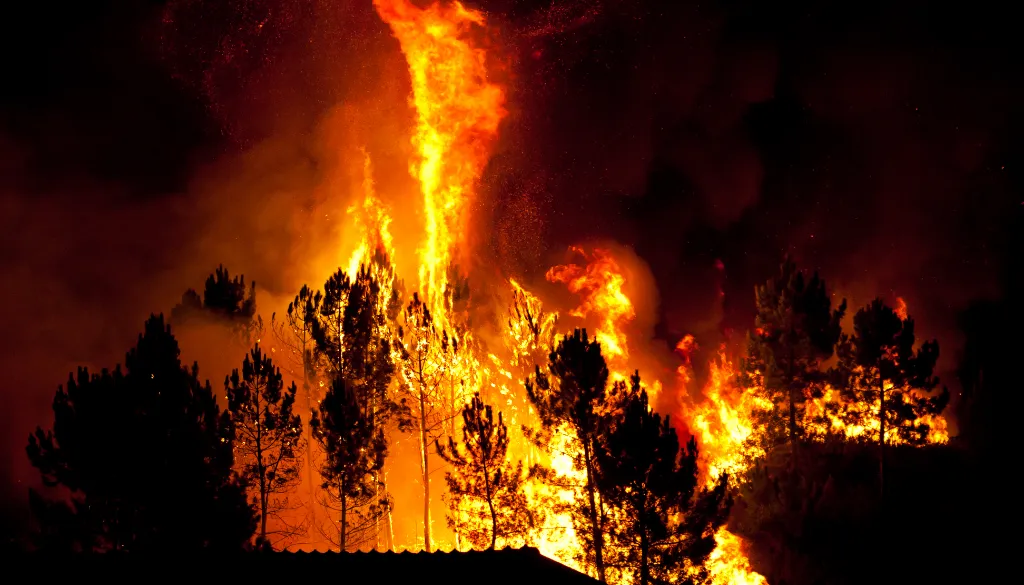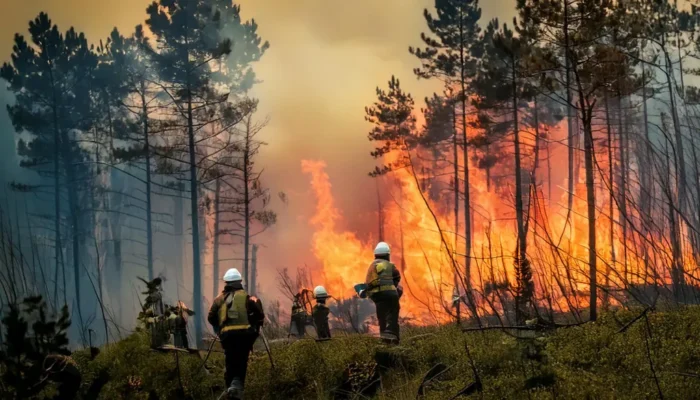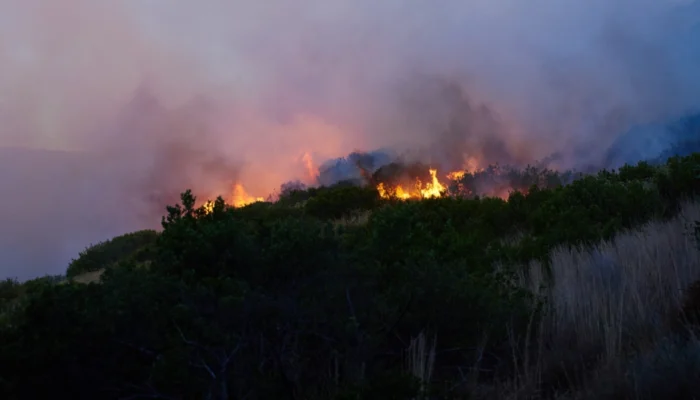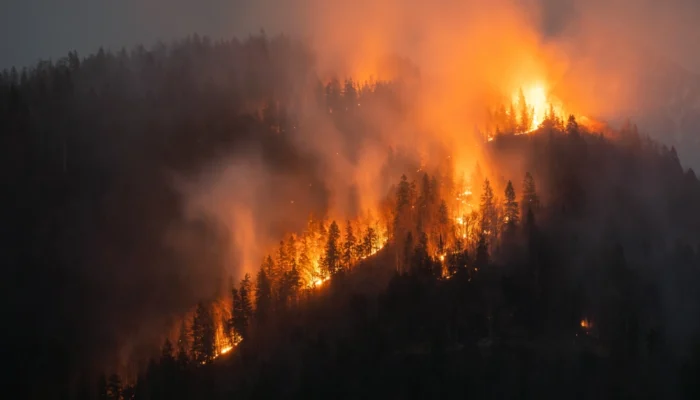During intense wildfires, something terrifying and almost unbelievable can happen. A spinning tower of flame rises into the air, roaring like a jet engine and hurling burning debris in every direction. This isn’t a scene from a movie it’s real, and it’s known as a fire whirl. These swirling columns of flame, sometimes called fire devils, firenadoes, fire swirls, or fire tornadoes, are among the most extreme and dangerous wildfire phenomena on Earth. While rare, they are becoming more common as wildfires grow in size and intensity due to rising temperatures and drier landscapes.
Understanding how fire whirls form, what makes them so destructive, and why they’re so hard to predict is key to keeping people and firefighters safe. This article explores the science, history, and future of these explosive events in simple language that makes the complex easier to understand.
Table of Contents
ToggleWhat Is a Fire Whirl?
A fire whirl is a spinning column of fire that can appear during a wildfire or even during a controlled burn. It starts when rising hot air from the fire begins to twist, forming a vortex that pulls flames and burning material into a vertical spiral. Fire whirls can be small, just a few feet tall, or massive, reaching hundreds of feet into the air.
They look like a tornado made of fire, but they are not true tornadoes. Still, some fire whirls are strong enough to cause damage like a tornado. That’s why the media often calls them firenadoes, a mix of the words fire and tornado. Other names, like fire devil or fire swirl, come from different cultures and descriptions, but they all refer to this spinning, flaming tower.
The key thing to understand is that fire whirls are not just interesting to look at—they are extremely dangerous. They can move quickly, spread the fire in unpredictable ways, and cause destruction far from the main fire line.
.
How Fire Whirls Form
To understand how a fire whirl forms, we have to start with the basics of heat and air movement. When a wildfire burns, it produces a lot of heat. This hot air rises very fast because hot air is lighter than cooler air. If the wind conditions are right, or if the fire is burning on uneven ground, the rising air can start to spin. That spinning air pulls in more hot gases, ash, and flames, creating a fire whirl.
It’s like a spinning chimney made of fire. The stronger the heat and wind, the taller and faster the fire whirl can grow. Sometimes, the ground and trees help guide the spinning motion, creating even larger and more dangerous fire whirls.
The science behind this process is complex, but one article that explains the basics really well is “Fire Trigonometry, knowledge hidden in triangles”. That article discusses the Fire Triangle and the Fire Behavior Triangle, explaining how fire behavior can be studied, which helps experts understand how fires and fire whirls grow and move.
Real-World Examples of Fire Whirls and Firenadoes
Fire whirls are not just science experiments—they’ve happened many times in real life, often with deadly results. Here are some historical examples, listed from the oldest to the most recent:
1871 – Peshtigo Fire (Wisconsin, USA):
- Deadliest wildfire in American history
- Over 1,200 people killed
- Witnesses described spinning fire columns tearing through forests
1923 – Great Kanto Earthquake (Tokyo, Japan):
- Fires broke out after a massive earthquake
- A huge fire whirl formed and swept through a park where thousands had taken shelter
- Over 38,000 people were killed in minutes
- One of the deadliest fire whirl events in history
2003 – Canberra Bushfires (Australia):
- Extreme fire behavior during major bushfires
- Witnesses saw spinning walls of fire launching burning logs
- The event influenced changes in firefighter training in Australia
2018 – Carr Fire (California, USA):
- Fire whirl with wind speeds up to 143 mph
- Classified as EF-3 tornado strength
- Caused major destruction: trees uprooted, roofs torn off, vehicles flipped
- Resulted in multiple fatalities
2021 – Dixie Fire (California, USA):
- Firefighters observed multiple smaller fire whirls
- Whirls spread flames unpredictably
- Made firefighting operations more difficult and dangerous
.
Why Fire Whirls Are So Dangerous
Fire whirls are not merely a rare curiosity; they represent one of the most perilous wildfire events that firefighters can encounter. The threat they pose stems from the combination of high-speed winds and intense heat. A fire whirl can propel flaming debris hundreds of feet away, igniting new fires well beyond the fire line. This characteristic makes them a primary factor in the sudden growth and spread of wildfires.
Additionally, fire whirls can move rapidly and alter their direction unexpectedly. This unpredictability makes them extremely challenging to combat, particularly from the ground. Firefighters risk becoming trapped if a fire whirl suddenly forms nearby. Even helicopters and airplanes engaged in aerial firefighting are vulnerable, as the strong winds and updrafts can jeopardize flight safety.
In summary, fire whirls are fast, unpredictable, and extremely destructive. They are among the key reasons why wildfire behavior is so difficult to predict and control, especially during large fires in dry, windy conditions.
.
Can Fire Whirls Be Predicted or Controlled?
Right now, scientists and firefighters are still learning how to better predict when and where fire whirls will happen. The challenge is that they depend on many small details—like wind speed, temperature, fuel type, and terrain shape—all working together in just the right (or wrong) way. Most weather models and fire behavior tools can’t zoom in close enough to spot the conditions that make fire whirls form.
However, there’s hope. New technologies are being tested that might give us better warnings. For example, drones and remote sensors are being used more and more to track fire behavior in real time. These tools can fly above wildfires and look for signs of dangerous air patterns. If they spot a spinning motion early enough, they might be able to warn crews on the ground.
To learn more about how this technology works, you can read “Can Drones and Sensors Spot Fires Before They Go Wild?”. This article goes into detail about how early detection and real-time data could be the key to spotting fire whirls before they grow out of control.
Even with all this tech, fire whirls remain one of the hardest parts of wildfire science. They happen fast, they move fast, and they leave behind destruction that looks like it was caused by a bomb or a tornado. But as we learn more and gather better data, we get closer to being able to understand and maybe even prevent some of their worst impacts.
.
Conclusion
Fire whirls—whether you call them firenadoes, fire devils, or fire swirls—are among the most dangerous and extreme events that can happen during a wildfire. They are spinning columns of fire and wind, formed when rising hot air and strong winds combine in just the right way. While they might look amazing, they are anything but safe. These fiery tornadoes can destroy homes, change the direction of wildfires, and put firefighters and communities at risk.
In recent years, fire whirls have become more common as wildfires themselves grow larger and more intense. Scientists and firefighters are working hard to understand these events and find ways to predict them, but it’s not easy. Articles like “Fire Trigonometry, knowledge hidden in triangles”, The Science Behind Wildfire Behavior: How Wind and Terrain Impact Fire Spread, and “Can Drones and Sensors Spot Fires Before They Go Wild?” all help show the ways experts are learning and adapting to this threat.
As we face more wildfires in the future, knowing about fire whirls could help keep more people safe and give firefighters a better chance to control the flames. Understanding fire, especially extreme events like fire whirls, is not just science, it’s survival.




